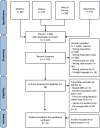Genetic polymorphisms and their association with neurobiological and psychological factors in anorexia nervosa: a systematic review
- PMID: 38979077
- PMCID: PMC11229080
- DOI: 10.3389/fpsyg.2024.1386233
Genetic polymorphisms and their association with neurobiological and psychological factors in anorexia nervosa: a systematic review
Abstract
Background and aims: Anorexia nervosa (AN) is a complex neuropsychiatric disorder. This systematic review synthesizes evidence from diverse studies to assess and investigate the association between gene polymorphisms and psychological and neurobiological factors in patients with AN.
Methods: A systematic search across PubMed, PsycINFO, Scopus, and Web of Science databases, along with manual searching, was conducted. The review protocol was approved by PROSPERO (CRD42023452548). Out of 1,250 articles, 11 met the inclusion criteria. The quality of eligible articles was assessed using the Newcastle-Ottawa Scale (NOS) tool. The systematic review followed the PRISMA guidelines.
Results: The serotoninergic system, particularly the 5-HTTLPR polymorphism, is consistently linked to altered connectivity in the ventral attention network, impaired inhibitory control, and increased susceptibility to AN. The 5-HTTLPR polymorphism affects reward processing, motivation, reasoning, working memory, inhibition, and outcome prediction in patients with AN. The dopaminergic system, involving genes like COMT, DRD2, DRD3, and DAT1, regulates reward, motivation, and decision-making. Genetic variations in these dopaminergic genes are associated with psychological manifestations and clinical severity in patients with AN. Across populations, the Val66Met polymorphism in the BDNF gene influences personality traits, eating behaviors, and emotional responses. Genes like OXTR, TFAP2B, and KCTD15 are linked to social cognition, emotional processing, body image concerns, and personality dimensions in patients with AN.
Conclusion: There was an association linking multiple genes to the susceptibly and/or severity of AN. This genetic factor contributes to the complexity of AN and leads to higher diversity of its clinical presentation. Therefore, conducting more extensive research to elucidate the underlying mechanisms of anorexia nervosa pathology is imperative for advancing our understanding and potentially developing targeted therapeutic interventions for the disorder.Systematic review registration: [https://clinicaltrials.gov/], identifier [CRD42023452548].
Keywords: anorexia nervosa; eating disorder; genetic polymorphism; genetic susceptibility; neurobiological factors; psychological factors.
Copyright © 2024 Almaghrbi and Bawadi.
Conflict of interest statement
The authors declare that the research was conducted in the absence of any commercial or financial relationships that could be construed as a potential conflict of interest.
Figures




Similar articles
-
Influence of TFAP2B and KCTD15 genetic variability on personality dimensions in anorexia and bulimia nervosa.Brain Behav. 2017 Jul 27;7(9):e00784. doi: 10.1002/brb3.784. eCollection 2017 Sep. Brain Behav. 2017. PMID: 28948079 Free PMC article.
-
The effect of single nucleotide polymorphisms on depression in combination with coronary diseases: a systematic review and meta-analysis.Front Endocrinol (Lausanne). 2024 Apr 30;15:1369676. doi: 10.3389/fendo.2024.1369676. eCollection 2024. Front Endocrinol (Lausanne). 2024. PMID: 38745947 Free PMC article.
-
[Posttraumatic stress disorder (PTSD) as a consequence of the interaction between an individual genetic susceptibility, a traumatogenic event and a social context].Encephale. 2012 Oct;38(5):373-80. doi: 10.1016/j.encep.2011.12.003. Epub 2012 Jan 24. Encephale. 2012. PMID: 23062450 Review. French.
-
Beyond the black stump: rapid reviews of health research issues affecting regional, rural and remote Australia.Med J Aust. 2020 Dec;213 Suppl 11:S3-S32.e1. doi: 10.5694/mja2.50881. Med J Aust. 2020. PMID: 33314144
-
A Systematic Review of Genetic Polymorphisms Associated with Binge Eating Disorder.Nutrients. 2021 Mar 5;13(3):848. doi: 10.3390/nu13030848. Nutrients. 2021. PMID: 33807560 Free PMC article.
Cited by
-
The need for research on orthorexia nervosa: looking back, looking forward.Eat Weight Disord. 2025 Jun 10;30(1):48. doi: 10.1007/s40519-025-01743-2. Eat Weight Disord. 2025. PMID: 40493121 Free PMC article.
-
The Effects of Intensive Residential Treatment for Feeding and Eating Disorders (FEDs) in Adolescence: The Case of an Italian Facility.Nutrients. 2025 Jun 1;17(11):1904. doi: 10.3390/nu17111904. Nutrients. 2025. PMID: 40507173 Free PMC article.
-
Association of the Val66Met Polymorphism of the BDNF Gene with the Depression in a Mexican Population with Multiple Sclerosis.Life (Basel). 2025 Jan 31;15(2):213. doi: 10.3390/life15020213. Life (Basel). 2025. PMID: 40003622 Free PMC article.
References
-
- Albuquerque D., Nóbrega C., Rodríguez-López R., Manco L. (2014). Association study of common polymorphisms in MSRA, TFAP2B, MC4R, NRXN3, PPARGC1A, TMEM18, SEC16B, HOXB5 and OLFM4 genes with obesity-related traits among Portuguese children. J. Hum. Genet. 59, 307–313. doi: 10.1038/jhg.2014.23, PMID: - DOI - PubMed
-
- Aluja A., Blanch A., Gallart S., Dolcet J.-M. (2010). The temperament and character inventory revised (TCI-R): descriptive and factor structure in different age levels. Psicol. Conduct. 18:385,
Publication types
LinkOut - more resources
Full Text Sources
Miscellaneous

